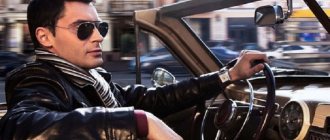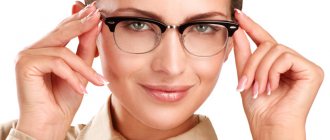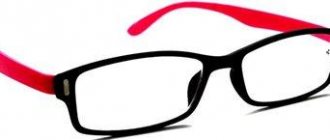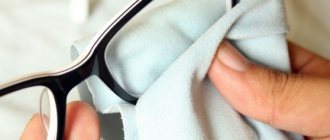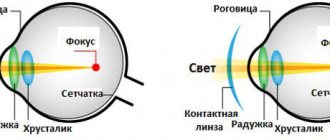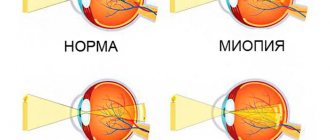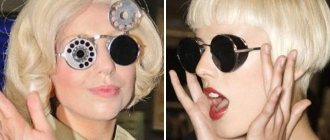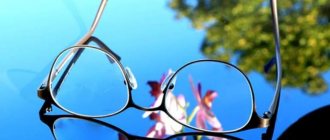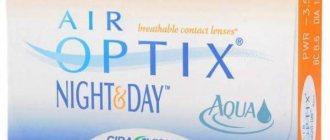HomeArticlesArticles about spectacle lensesWhat types of spectacle lenses are there? Which glasses to choose for driving at night
Published:
Back to archive
Driving in the dark is very dangerous, since poor road lighting, as well as variable illumination due to the bright headlights of oncoming cars, cause an increase in the number of traffic accidents. In addition, driving, especially at night, causes severe eye strain and deterioration of vision and, accordingly, visibility and reaction on the road.
Features of night driving
There are several hazards of night driving that reduce a driver's visibility of the road ahead. Special glasses for driving at night will help you cope with these factors.
1. Decreased vision in the dark. Poor lighting causes decreased visual acuity - myopia - even in people who can see perfectly under normal conditions. A special term was even introduced for this phenomenon - “night myopia”. As a result, a person focuses his vision at a closer distance, and the contrast of the image decreases.
2. Bright lights from oncoming cars. One of the biggest risks of driving at night is glare from headlights. In addition to the fact that at the very moment the bright light appears, the driver completely loses control over the situation on the road, the blinding may continue for some time, because visual adaptation in low light conditions occurs slowly.
3. Glare and reflections. At night, reflections can form around light sources, which also have a distracting and blinding effect. The formation of reflections can be influenced by dirt on the windshield or glasses lenses, so when driving at night you need to pay special attention to the cleanliness of the glass.
4. Reducing image contrast. Low image contrast leads to rapid eye fatigue and eye strain, which can also be critical when driving a car. Not only does poor lighting cause a decrease in contrast, but also glare and reflections on the road.
The optimal choice of glasses for motorists is the key to your safety
• Driving without sunglasses is dangerous • Choosing glasses for motorists. Advantages and disadvantages. Expert opinion • With tinted lenses; optimal level of tint • Photochromic glasses • Polarized glasses: operating principle, suitability for driving • Glasses with special coatings • Glasses for night driving • Recommendations for glasses wearers • Frames and shapes: what to choose for a car enthusiast • What to avoid when choosing sunglasses for driving a car
Summer warmth and sunshine delight the heart and eye.
However, blinding rays can play a cruel joke on the driver of a vehicle if he does not take care in advance how to avoid trouble from bright light. Of course, sunglasses are fashionable and cool. And many want to imitate the first macho man and Formula 1 champion Lewis Hamilton, who loves to pose in designer models. But traffic safety is much more important than beauty: “anti-solar” glasses can provide it. See also How traffic police officers tell drivers who use lenses instead of glasses
While driving around the city, highway or country roads, the sun hitting the eyes, road dust, glare from the windshield can cause the driver to lose attention and get distracted. This becomes one of the main causes of road accidents. Choosing the right pair of driving glasses will not only protect your eyes, but also help save you from road hazards.
Remember: not all models are equally effective. An error in choosing glasses can affect the condition of your eyes. It is not uncommon for a superficial attitude towards one's own vision to lead to problems such as macular degeneration, retinal damage and cataracts.
Which driving glasses are the most optimal, what should you pay attention to when choosing and purchasing? There are many types and models: from trendy and extravagant to classic. Below are some of our recommendations based on expert opinions and findings.
Top 5 glasses from reliable manufacturers
There are a large number of driving glasses of domestic and foreign production on the modern market. Many of these products have proven themselves to be excellent.
Polaroid Core P4039-A4X68HE
This model from the famous manufacturer is distinguished by its visual appeal. Copper-toned, teardrop-shaped glass with nine layers encased in a metal frame is perfect for both men and women.
These glasses are intended primarily for daytime use and at dusk, perfectly absorbing glare. Disadvantages include high cost and a certain fragility of the frame arms.
Smart View Elite
The stylish design and interesting shape of this glasses model attract many drivers. The product effectively protects from bright headlights, direct sunlight, and maintains good visibility in rain and fog. This optics reduces eye strain and maintains their performance at a high level.
The advantages of the model are high wear resistance, safe material, versatility, modern design, and wearing comfort. An obvious disadvantage is the appearance of play over time.
Autoenjoy Fashion SM02G
This optic is ideal for serious racers as it meets the most stringent requirements, combining protection, reliability and comfort. The anti-reflective coating inside the lens effectively prevents glare. A strong, comfortable frame, optimal equipment, and compliance with European standards fully justify the price of 6,300 rubles.
AS 001 Anti-lights
These glasses are characterized by increased wear resistance and reliability. They are versatile as they are suitable for day and night use. The product perfectly protects the eyes from the harmful effects of ultraviolet rays. In addition, this model makes it possible to use lenses with diopters.
The only drawback is that your eyes get tired from wearing it for a long time. Despite this, driver reviews of the product are mostly positive.
Lectio Risus Grand Voyage
The classic shape of the product complements the male or female look. Drivers note the convenience, comfort, and image clarity when using these glasses while driving.
In the evening, in fog, rain, when visibility is limited, GRAND VOYAGE optics provide good visibility. Yellow polymer lenses eliminate the harmful effects of headlight glare and glare.
See also:
How to choose lamps for fog lights
Thus, when choosing glasses, you should familiarize yourself with the most popular models. These products should be purchased in specialized stores. It is better to consult with a specialist who will help you choose the most optimal option for each specific case.
4 comments
- Mikhail says:
I somehow didn’t bother with this before, but the number of accidents is increasing and I decided to buy glasses for night driving, a very convenient thing. - Sasha says:
Well, yes, at night sometimes the headlights of oncoming cars are so blinding that it’s simply impossible without glasses. My husband has some and they seem to be quite good, really convenient. - Nikita says:
My friends gave it to me for my last birthday. Cool thing, driving at night has actually become much more convenient. - Asya says:
My father wears these while driving and says that there is a real need for such glasses.
The main dangers of driving without sunglasses
It is wrong to think that sunglasses are a purely summer wardrobe accessory. “Frost and sun; “It’s a wonderful day”... One of the main problems while driving is the distracting effects of glare from strong sunlight. Both in winter and in summer.
See also: How traffic police officers deceive drivers who use lenses instead of glasses
“The brighter the sun, the greater the glare effect. The pupils of the eyes narrow, and glare reduces not only the sharpness, but also the contrast of vision, that is, the ability of the eye to distinguish objects in low light or against a similar background in color, says Franz Solzig, head of sales at Fielmann, a famous German optics brand. this reduces the driver’s sensitivity to the situation on the road.”
This is also facilitated by reflections from mirrors, wheels and bodies of cars in front and neighboring cars, and reflections from a wet road. The active sun creates sharp changes in light and shadow. Remember: our eyes can quickly go from dark to light, but the reverse transition takes much longer. “Therefore, when entering a tunnel, you must take off your sunglasses. Otherwise, you may not notice other vehicles,” advises German ophthalmologist Kerstin Kruszynski.
Which glasses are suitable for driving? Recommendations by K. Krushinsky
With Tinted Lenses Expert: “Glasses with lightweight tinted plastic lenses and, ideally, anti-reflective coatings can significantly reduce unwanted light reflexes. The hue largely depends on the specific lighting conditions. If you're driving on a bright sunny day, it's brown or gray because the colors of traffic lights and brake lights don't affect them. And when driving on a cloudy day, at dusk or at dawn, it is more likely red, orange, amber. Unsuitable are glasses with a yellow filter, which for some reason are often sold as glasses for night driving.
See also How to survive a hot summer in a car: Basic tips
Reason: They absorb a lot of light, which is naturally undesirable in the dark. In addition, they do not have sufficient anti-glare effect. The main disadvantage of glasses with tinted lenses is that they cannot be used for all situations of varying lighting conditions while driving.”
Selecting spectacle lenses
Spectacle lenses for motorists must be selected with special attention, since the risk of a driver getting into an accident depends on their quality.
Choosing the wrong lenses can have dire consequences.
The lenses of glasses for driving in the dark have a polarizing coating that protects the eyes from bright glare that occurs when light is reflected from horizontal surfaces - water, ice, snow, glass, etc.
Read what lenses for glasses with diopters are used for here.
The polarizing film of these glasses is designed in such a way that it transmits only vertically polarized light rays.
Polarized lenses have many advantages:
Lens palette
- They fully protect against ultraviolet radiation that is harmful and dangerous to the eyes;
- Increase visual acuity;
- Helps eliminate intense and bright glare;
- Eliminates glare when shining bright light into the eyes and relieves tension;
- Maintains image clarity and color perception.
Filters in glasses for driving at night do not transmit the violet-blue part of the spectrum, which makes it difficult to focus on an object. Therefore, lenses designed for night driving are yellow, red, and orange.
Kinds
Lenses for glasses for motorists can be of various types. Lenses can be made of glass or plastic. For driving, it is still recommended to purchase plastic lenses to ensure safety . In the event of an accident, there is less risk that plastic lenses will injure your eyes. In addition, the weight of plastic lenses is half that of glass. Thanks to this, plastic glasses are lighter and more comfortable to use. The main thing is not to forget that care for night lenses is necessary.
How to choose the right one
When choosing glasses for driving at night, you need to pay special attention to some features:
- First of all, you need to choose the color scheme of the lenses. It is advisable to choose lenses in yellow or light brown tones. These tones are most effective at blocking a certain range of colors from visible light, resulting in clearer images and less eye fatigue. Warm shades of lenses are ideal for drivers, as they do not distort the colors of traffic lights and car lighting equipment.
- The level of protection against ultraviolet rays does not need to be taken into account if glasses are purchased in order to use them at night. It would be better to purchase glasses to protect your eyes from the computer. They can be used during the day. However, if the glasses will also be used during the daytime, it is advisable to choose glasses with a high level of ultraviolet protection - UV380 - UV400.
- The light transmission of glasses must be at least 75%. According to the international ISO standard, this is exactly the amount of light they must transmit to ensure good visibility.
- It is recommended to buy glasses from trusted stores that can guarantee to provide an optically correct lens, instead of fake glasses with curved tinted plates. Lenses must be polarized. It is this property of glasses that reduces the brightness and increases the contrast of the image, thus reducing visual strain.
As a rule, in good, reputable stores, when purchasing glasses with polarized lenses, they will provide you with a special sign, the inscription on which you can only see through polarized lenses.
This proves their authenticity and quality. To distinguish real, high-quality polarized lenses from fake ones, you can also conduct an independent check.
are used for this :
- Place the glasses in a horizontal position opposite the display of an electronic device (computer, phone, tablet) and rotate them 90 degrees to a vertical position. The lens should darken.
- Put on one pair of polarized glasses and pick up another. Rotate the glasses 90 degrees and look at the lenses. If they darken, then the glasses have a polarizing filter.
- Take a look at the glass of the display cases reflecting objects wearing glasses with polarized lenses. The glare will disappear and the glass will become transparent. You will see what is behind the glass of the display case without any visual interference.
Don't skimp on glasses with polarized lenses.
Typically, a product with low quality is sold at a low price. Such a product will not last long and, in addition, can cause significant damage to vision. It is better to give preference to well-known brands when buying glasses for driving a car.
Tinted lenses: what level is recommended for driving?
There are 5 levels of lens tint: from 0 to 4. Levels 2 and 3 are suitable for use as driving sunglasses. They transmit from 43 to 8 percent of light. Typically, experts recommend sunglasses with an average level of light transmission of 25-35%, otherwise with a medium-tinted filter.
Expert: “The highest, level 4, with very dark windows is completely unacceptable for driving. Their light transmittance is only 3-8 percent, and driving a car with such glasses is extremely dangerous.”
Photochromic glasses (chameleons)
Expert: “A convenient choice for motorists, since the tint level is set in accordance with the lighting conditions. They darken from excess ultraviolet light and lighten in low light. Photochromes provide good anti-glare protection on top and give a clear view down to the controls. However, you should also be careful with them. A car windshield already blocks a certain amount of UV rays, so chameleon lenses may produce a darker light output than they actually are.”
Polarized glasses. Operating principle and suitability for driving
As already mentioned, one of the critical factors in the impact of sunlight on a driver is glare. They interfere, tire, irritate. The nature of glare is as follows.
In optics, a distinction is made between horizontal and vertical light rays. The peculiarity of human vision is such that vertical rays do not interfere with perception and the picture of the surrounding world that appears in the brain is clear and realistic, without distortion. However, horizontal rays overlap it and interfere with adequate visual perception. Polarization allows you to eliminate the imbalance. Polarized glasses are equipped with a special liquid crystal film filter between the layers of the lens. The filter film blocks horizontal light, and vertical light rays freely enter our eyes, creating a natural view.
See also Physics: how to accelerate a car using headlights and why does this happen?
Expert: “Polarized sunglasses are the ideal solution to combat glare and glare. Regardless of weather conditions, be it sun or fog, they will help cope with reflections that occur on a wet track, as well as enhance the contrast of perception. Which certainly helps improve road safety.”
Features of photochromic lenses for driving
For comfortable and safe driving, the color of your lenses also plays an important role. As a rule, photochromic driving glasses are made in brown - it provides optimal color rendition and better contrast compared to other chameleon colors. But if you wish, you can choose any of the colors offered by the manufacturer.
Good contrast allows you to clearly see details in any lighting (including at dusk and in cloudy weather) and have a clearer “picture” before your eyes.
As a rule, lenses for drivers are additionally equipped with a special polarizing filter. It blocks sun glare reflected from the car hood, headlights of oncoming cars and wet road surfaces, for example, after rain.
Driving glasses block glare, darken even visible light and improve image contrast
Polarizing coating is very important for your safety, as glare creates a potential hazard on the road - glare often causes accidents. In addition, polarization provides a relaxing effect for the eyes, since constant glare can lead to overstrain of the eye muscles. This is especially true for people who have increased sensitivity to bright light.
Glasses with special coatings
Expert: “They have a number of additional advantages. Special lens coating provides improved vision clarity and comfortable driving. There are various coatings available such as anti-glare coating which reduces the glare that affects your vision while driving, anti-glare coating which eliminates annoying reflections. You may also want to opt for an anti-scratch coating, as scratches on glasses can obstruct your vision and become a distraction while driving.”
Night driving glasses
Not only can daytime ultraviolet light become a distraction factor, but so can low light levels during night driving. And here, tinted sunglasses are definitely not the solution. Suitable during the day, at night they impair visibility and are therefore dangerous.
See also Night: 9 tips for driving after dark
Expert: “Driving a car at night with sunglasses should be taboo! This increases the risk of an accident because the driver has difficulty seeing not only other road users, but also the highway itself with its warnings and signs. They are either not perceived in the dark, or are noticed too late. The best choice for night driving is glasses with clear lenses and anti-reflective coating. These models reduce reflections without compromising visibility and ensure safety while driving at night.”
How do photochromic lenses for drivers differ from regular lenses?
Leading manufacturers of spectacle lenses offer motorists a separate line of photochromes. Such lenses react not only to UV exposure, but also to visible light. Why is it important? Windshields and side windows in modern cars are able to block most ultraviolet radiation. This means that photochromic lenses do not react to changes in lighting and either remain transparent or darken slightly in the car. However, your eyes still need protection from blinding sunlight, especially on the road.
A new generation of spectacle lenses with photochromic properties, designed specifically for driving, change their darkening even when exposed to visible light. The glasses react quickly to changing lighting conditions and can darken partially or completely, depending on the intensity of sunlight.
At the same time, in the dark, the glasses remain transparent and provide good visibility.
Recommendations for people with glasses
If you already wear glasses, what is the best eye protection for your eyes while driving?
Expert: “Motorists who constantly use glasses or contact lenses to correct their vision also need sunglasses with the appropriate diopter. Some opticians offer a discount when a client buys not only one, but two pairs of glasses designed for the same vision. Then you get sunglasses much cheaper. Alternative: Buy auto-clips for your regular glasses and quickly fold them before entering the tunnel. Another option is to use contact lenses over which you wear non-prescription sunglasses. Important! Never drive while wearing glasses with glass lenses. In an accident, glass can critically damage the eye, unlike plastic, which in the worst case scenario will crack or fall out of the frame without any damage.”
It should be remembered that in Russia there are a number of restrictions on driving personal vehicles for people with impaired vision.
What are photochromic lenses
Photochromes are glasses whose lenses darken under direct exposure to ultraviolet light. That is, the glasses remain transparent indoors, but outdoors they gradually darken and protect the eyes from bright light. These glasses are also popularly known as “chameleon” glasses.
Such lenses are sensitive to changes in lighting and adapt to it. At the same time, they perform a corrective function and replace sunglasses for people who need vision correction. This is very convenient because you maintain sharp vision and at the same time receive high-quality protection from bright light.
Frames and shapes: what to choose for a car enthusiast
Expert: “It is recommended to use glasses with narrow frame edges and thin bars, as they do not limit the field of view. Plus big glasses. Make sure the frame is out of your field of vision. This is necessary for viewing the rear view mirror. Don't forget about aviator style models. It's a style that's always in fashion, as well as essential functionality and comfort, because classic aviator sunglasses in most cases come with 100% UV protection, which protects your eyes from the sun's harmful rays and ensures safe driving."
Advantages and disadvantages
pros
- Special photochromic lenses react not only to UV radiation, but also to visible light - they adapt to the current lighting and darken depending on its intensity;
- Polarized coating helps block glare for a more comfortable and safe driving experience on sunny days;
- Increased contrast in the lenses provides a clear “picture” in the dark and cloudy weather.
Minuses
- Such lenses are more expensive than conventional photochromes;
- Glasses need to be changed approximately every three years, and if the polarizing coating is damaged (which can happen due to improper care), then the glasses will have to be replaced even earlier;
- Glasses with a polarizing filter cannot be used at night.
